“设计中的设计-”英语读后感
设计学概论读后感英文
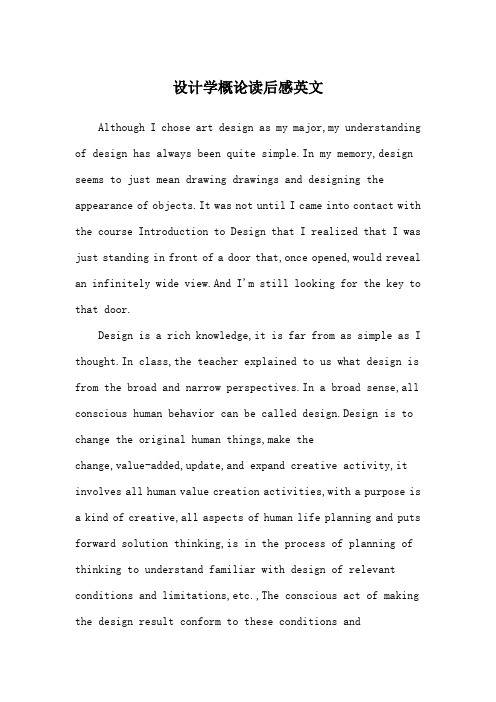
设计学概论读后感英文Although I chose art design as my major,my understanding of design has always been quite simple.In my memory,design seems to just mean drawing drawings and designing the appearance of objects.It was not until I came into contact with the course Introduction to Design that I realized that I was just standing in front of a door that,once opened,would reveal an infinitely wide view.And I'm still looking for the key to that door.Design is a rich knowledge,it is far from as simple as I thought.In class,the teacher explained to us what design is from the broad and narrow perspectives.In a broad sense,all conscious human behavior can be called design.Design is to change the original human things,make thechange,value-added,update,and expand creative activity,it involves all human value creation activities,with a purpose is a kind of creative,all aspects of human life planning and puts forward solution thinking,is in the process of planning of thinking to understand familiar with design of relevant conditions and limitations,etc.,The conscious act of making the design result conform to these conditions andlimitations.Design can be said to be the hidden nature of human beings.When young children pile up building blocks together or doodle on paper,the question of"what to do"is subconsciously revealed in their minds.When children express their inner dream world with their tender hands,they are full of vague creative passion.This is the expression of design thinking.When a modern woman buys a piece of clothing that pleases her heart,there will always be uncontrollable joy,because they have found the most appropriate position in the"self-image design",and use their clothes to interpret the"standard of beauty".These are the embodiment of people's design consciousness in daily life.In a narrow sense,design is a comprehensive discipline engaged in human material culture and spiritual culture.It is not only the thinking and research on the combination of production technology and art,but also the extensive field of natural science and social science.Includingphysics,physiology,psychology,aesthetics,mathematics,materi als,crafts,ergonomics,value engineering and economic management,marketing and advertising and other broad knowledge.Design is closely related to our life.The category of design involves almost every aspect of people's lives.Designis a mirror,it can accurately project the development of The Times,social concern,cultural,economic changes,especially the change of production mode.So sociologists often take concrete creations as important clues to study social development.However,on the other hand,design has a certain initiative in the process of forming a lifestyle.That is,in a certain space,leading the way of life to develop forward from the subtle.As a kind of enhancement and extension of human function,product function and human function have identity and difference.On the one hand,it enhances people's ability to move and expands their range of activities.On the other hand,it gives rise to abilities(such as flight)that humans did not previously possess.Therefore,from the perspective of the relationship between products and people,the creative significance of design is reflected in the breakthrough of social conventions and the change of people's way of life and labor.From this point of view,design has some significance beyond the current state of life.Its innovation leads a new consumption trend and creates a new lifestyle.In contemporary society,design has become an important symbol of wealth creation and a powerful support for international competitiveness.Today's society is an era of perceptualconsumption,but also a pursuit of brand-name consumption,to enjoy brand-name proud of the era,and the emergence and development of brand-name is closely related to design.Design has become a kind of invisible productivity and a powerful means to create high added value of goods.It is the ultimate goal of design to create new means of life and production to meet the existing material production conditions,so as to constantly improve the way of life.It is also one of the driving forces for the continuous progress of human society.In class,the teacher also talked about the traditional design concept of China.When listening to it,I always felt deeply attracted by it,but it seemed that I was walking through clouds and fog and did not know what to make of it.China is a country with a long history of 5,000 years.In its long history,China has created many works of far-reaching influence in the history of world civilization and played an important role in promoting the development of world civilization.In China,design has been around since ancient times.Traditional Chinese design upholds the concept of natural creation.This is the first part of the exploration and respect of natural laws.In class,the teacher talked about a sentence in Zhou Li Kao Gong Ji,the first monograph comprehensivelyrecording handicraft historical materials in China:"The sky is sometimes,the earth is Qi,the material is beautiful,the work is skillful,and then the four can be good."Of course,I didn't know what it meant until I looked it up.This sentence describes the creation thought of system theory,clearly puts forward the elements of creation design,and points out that the coordination among the four is the fundamental problem to be solved in design.The design idea of"the right time,the right location,the right materials and the right dexterity"still has profound theoretical and practical significance until today.Such insightful views were put forward by our ancestors thousands of years ago,and I can't help but feel proud and admired for their wisdom.In the long culture of creation,the respect for nature is also reflected in the protection of resources and the rational use of materials.The packaging design of lacquerware in the Han Dynasty was very delicate.For example,the"Hundred boxes"fully considered the volume and space between utensils and containers.Dozens of tableware were organically placed in a box,which not only saved space,but also reduced the waste of pared with the ecological design concept that emerged in the West after the oil crisis in the 1970s,China'straditional culture of creation gives people profound enlightenment.In ancient China,Confucianism and Taoism both influenced traditional Chinese design.In"Zhuangzi",there is a saying that"the creator is a man".This statement points out that the creator is man himself.Creation is a kind of humanized nature,is the product of the large system of nature.Creation is not an antithetical being,but an integral part of human life.Creation not only provides people with use functions,but also realizes people's re-creation of life style through the mining of functions.In this culture of creation,people's physiology and psychology have reached a natural state,which is comfortable,reasonable,healthy and relaxed.This view of nature advocates the harmonious coexistence of man and nature,and solves the problem of natural scale and social scale in design."Harmony between things and myself"and"combination of beauty and goodness"are all design concepts worth learning from.Due to the backward science and technology of modern China,China's design is also backward,which has shown the weak reality of more than one hundred years behind today.The Western design view is in the mainstream position in the modern and contemporary design world.And now,what kind of style is thedesign presented in front of us?In Aesthetics,Baulev said that design,in a certain sense,is the result of the infinite expansion of the scope of practical art,the development on the basis of industry,and the result of the infiltration of aesthetics into technology and artists into the middle area of production.This reflects the design concept of industrial society.Thesimplicity,conciseness,functionality,standardization and economization established by modern attention design have become one of the most important evaluation elements in contemporary design.The idea of"form follows function"has been criticized by postmodern theorists.But there is still a gleam of rationality.This design principle and practice based on the productivity of industrial society in the era of abstinence and reconstruction greatly promoted the modernization of life style.Modern design products,such as television,telephone and car,have rapidly entered thousands of households,bringing a convenient,fast and efficient pace of life and promoting a comprehensive change in life style.Nowadays,the design has gradually stepped into the postmodernism from the modernist design,but the influence of modernism can not beignored.Post-modernist design is a return to decorationism andhistoricism on the basis of modernism,which is completely different from mechanical retroism,and gradually clears up the indifference and depression that the internationalism style used to stay in the vision and psychology of modernist design.As a art design of learners,facing the rapid development of the design of the world,we should be clear that a designer to what is the contribution of the world need,the importance of clear design so as to understand the value of their own learning,clear the world of the past for we can absorb the wealth and clear design ideological trend of contemporary world.To be an excellent designer,one should have the ability to solve practical design problems with comprehensive knowledge,the sense of innovation and creativity,the generous humanistic quality,the ability to effectively express and communicate,the habit of lifelong learning and a high sense of social responsibility.We should take this as our goal,and continue to learn and improve ourselves.。
英语教学设计读后感范文
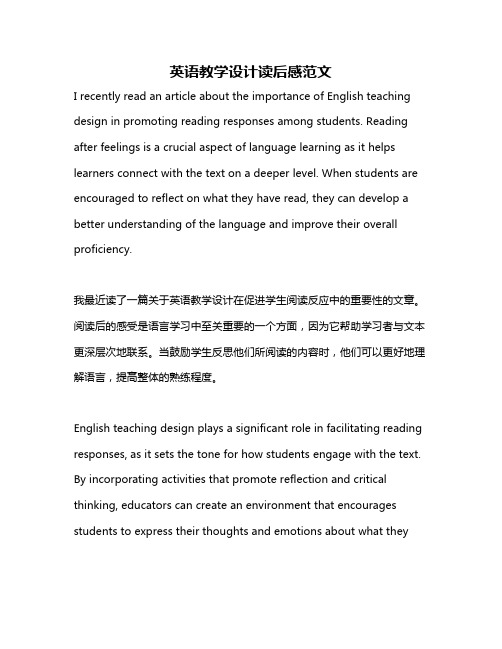
英语教学设计读后感范文I recently read an article about the importance of English teaching design in promoting reading responses among students. Reading after feelings is a crucial aspect of language learning as it helps learners connect with the text on a deeper level. When students are encouraged to reflect on what they have read, they can develop a better understanding of the language and improve their overall proficiency.我最近读了一篇关于英语教学设计在促进学生阅读反应中的重要性的文章。
阅读后的感受是语言学习中至关重要的一个方面,因为它帮助学习者与文本更深层次地联系。
当鼓励学生反思他们所阅读的内容时,他们可以更好地理解语言,提高整体的熟练程度。
English teaching design plays a significant role in facilitating reading responses, as it sets the tone for how students engage with the text. By incorporating activities that promote reflection and critical thinking, educators can create an environment that encourages students to express their thoughts and emotions about what theyhave read. This not only enhances their language skills but also fosters a love for reading, which is essential for lifelong learning.英语教学设计在促进阅读反应方面发挥着重要作用,因为它为学生如何与文本互动设定了基调。
设计中的设计读后感ppt

书中作品及分析/ Analysis of works
第二章REDESIGN 再设计 例2: 设计师面出薰设计了一款与工业化生产出来的整齐划 一的传统火柴形象不同的产品,他将小枯枝顶部涂上 可燃物,人们在使用时仿佛不自觉地回到了简单的远 古时代,重新思考火、人与自然之间的关系。而枯枝 本身的不规则就带有一种苍老、简约而又不廉价的美 感. 以日常用品的再设计为契机,旨在让麻木于现有生活 环境下的人们重新认识、体察到生活中的细节和乐趣。
14
书中作品及分析/ Analysis of works
信息建筑的思维模式: 例4:两所医院的截然不同的医院视觉指示系统设计。 梅田医院是一所产科和小儿科专科医院,住院的病人需要舒适 洁净的环境,因此大部分标识采用柔和的白布进行展示,白布 很容易脏,因此需要经常换洗,这也是设计的一个重点——用 易脏的白布的洁白光洁来展示对环境卫生的优良。 公立刈田综合医院需要体现其专业性,标示是用红色的大字显 示在地面上,人行走在标识上抵达目的地,此设计简洁明了, 给人一种专业、紧张的氛围。 产品的设计要贴合用户的实际需求,使其可以在日常的体验中 获取最合适、贴切的感受。
Our Impression
通过一本书的沟通认识,我觉得这是一个热爱生活的人。因为只有热爱生活的人,才愿意把心思花在视觉、
触觉的感知上。在阅读这本书的时候,总能不自觉地体验到作者的细致和自信、微妙的生活情趣以及丰盈的
人生智慧。
4
About The book
1. 封面 设计中的设计一书以白色为底,封面只有必有的书籍信息(书名、作者、及出版社),这样的书面封皮设计风
5
书中基本概况及主要思想
In the book Basic overview and main ideas
读后感
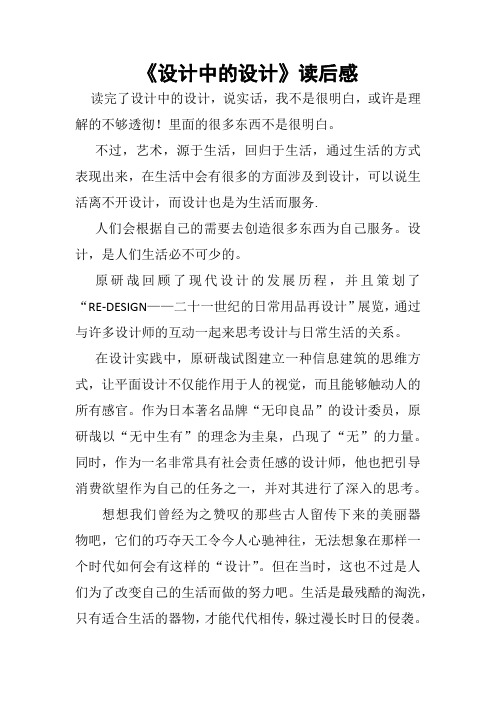
《设计中的设计》读后感读完了设计中的设计,说实话,我不是很明白,或许是理解的不够透彻!里面的很多东西不是很明白。
不过,艺术,源于生活,回归于生活,通过生活的方式表现出来,在生活中会有很多的方面涉及到设计,可以说生活离不开设计,而设计也是为生活而服务.人们会根据自己的需要去创造很多东西为自己服务。
设计,是人们生活必不可少的。
原研哉回顾了现代设计的发展历程,并且策划了“RE-DESIGN ——二十一世纪的日常用品再设计”展览,通过与许多设计师的互动一起来思考设计与日常生活的关系。
在设计实践中,原研哉试图建立一种信息建筑的思维方式,让平面设计不仅能作用于人的视觉,而且能够触动人的所有感官。
作为日本著名品牌“无印良品”的设计委员,原研哉以“无中生有”的理念为圭臬,凸现了“无”的力量。
同时,作为一名非常具有社会责任感的设计师,他也把引导消费欲望作为自己的任务之一,并对其进行了深入的思考。
想想我们曾经为之赞叹的那些古人留传下来的美丽器物吧,它们的巧夺天工令今人心驰神往,无法想象在那样一个时代如何会有这样的“设计”。
但在当时,这也不过是人们为了改变自己的生活而做的努力吧。
生活是最残酷的淘洗,只有适合生活的器物,才能代代相传,躲过漫长时日的侵袭。
而艺术也好,文明也好,借着这些物质存在,才为我们所感知、认识、欣赏、继承。
“信息构筑”的设计也是广义上的“信息设计”:“设计不是一种技能,而是捕捉事物本质的感觉能力与洞察能力”。
这句话或可代表作者的“设计观”,设计是我们观察和认知世界的一种方式,原研哉对设计的认知中心,一切都是以“建筑”为核心而生发出去的,作者曾说过:“建筑是综合一切的最高水平……平面设计、工业设计、纺织品设计等只不过被看成被建筑统一前的低水平的、被切割成片的小房间而已”。
正是这种设计观直接决定了作者对“设计”内部的理解,如果说在杉浦康平这里,设计之所以成为设计是最重要的,在“作品”里找到“造型”的源头,在天地人的“形式”里找到共鸣的造物方式;原研哉更关注的是“信息”的形态,他的“设计”是一个信息流动的“黑箱”,即设计学是一种潜在的“交流学”设计是信息传达的一个端口,设计师似乎是站在这个端口的守望者。
设计感想作文模板英语高中

设计感想作文模板英语高中Design Sense Reflection。
Design sense is an essential quality that can greatly influence our daily lives. From the clothes we wear to the furniture in our homes, design plays a significant role in shaping our experiences and perceptions. As a high school student, I have come to appreciate the importance of design sense and its impact on the world around us.First and foremost, design sense is about creating a harmonious and aesthetically pleasing environment. Whether it's the layout of a room, the color scheme of a website, or the packaging of a product, good design can enhance our visual experience and evoke positive emotions. For example, when I walk into a well-designed space, I feel a sense of calm and order, which can greatly improve my mood and mindset. On the other hand, poorly designed spaces can be chaotic and overwhelming, leading to feelings of discomfort and unease.In addition to its aesthetic value, design sense also plays a crucial role in functionality and usability. A well-designed product not only looks good but also works well. For instance, a user-friendly smartphone interface allows us to navigate seamlessly through apps and features, making our lives more convenient and efficient. Similarly, ergonomic furniture and appliances are designed to maximize comfort and practicality, enhancing our daily experiences and activities.Moreover, design sense is closely linked to innovation and creativity. In today's fast-paced world, new ideas and solutions are constantly being sought after, and design plays a key role in bringing these ideas to life. Whether it's a groundbreaking architectural design, a revolutionary technological gadget, or a cutting-edge fashion collection, innovative design can push the boundaries of what is possible and inspire new ways of thinking and living.Furthermore, design sense can also reflect cultural and social values. Different cultures and societies have their own unique design traditions and aesthetics, which canbe seen in architecture, art, fashion, and various other aspects of daily life. For example, traditional Japanese architecture emphasizes simplicity, minimalism, and harmony with nature, reflecting the values of tranquility and mindfulness. Similarly, the vibrant colors and intricate patterns of African textiles and crafts reflect the rich cultural heritage and traditions of the continent.As a high school student, I have had the opportunity to explore and develop my own design sense through various experiences and activities. From art classes and design workshops to visits to museums and galleries, I have been exposed to a wide range of design styles and concepts, which have broadened my understanding and appreciation of design. I have also had the chance to apply my design sense in projects and assignments, which has allowed me to develop my creativity, problem-solving skills, and attention to detail.Looking ahead, I believe that design sense will continue to play a crucial role in shaping our world and our experiences. As technology advances and global connections grow stronger, the need for innovative and thoughtful design will only become more important. Whether it's in the fields of architecture, fashion, product design, or digital media, the ability to create meaningful and impactful designs will be a valuable skill for the future.In conclusion, design sense is a multifaceted and influential aspect of our lives, impacting our visual, functional, and cultural experiences. As a high school student, I have come to appreciate the significance of design sense and its potential to shape the world around us. By developing and nurturing our design sense, we can not only create beautiful and functional environments but also inspire and innovate for the future.。
《设计中的设计》阅读感想
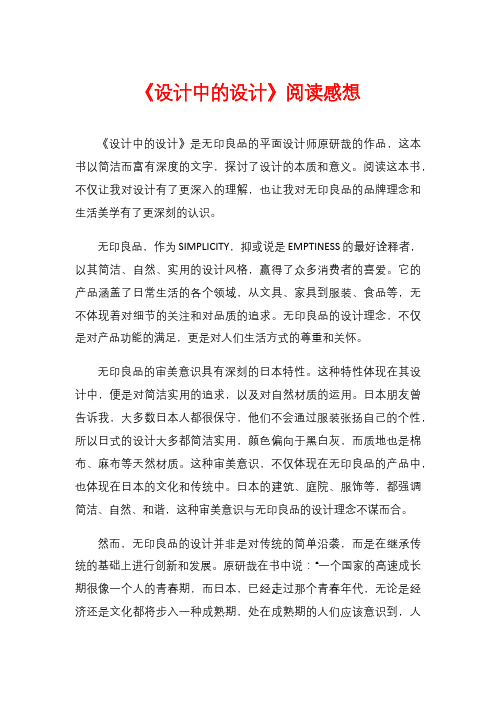
《设计中的设计》阅读感想《设计中的设计》是无印良品的平面设计师原研哉的作品,这本书以简洁而富有深度的文字,探讨了设计的本质和意义。
阅读这本书,不仅让我对设计有了更深入的理解,也让我对无印良品的品牌理念和生活美学有了更深刻的认识。
无印良品,作为 SIMPLICITY,抑或说是 EMPTINESS 的最好诠释者,以其简洁、自然、实用的设计风格,赢得了众多消费者的喜爱。
它的产品涵盖了日常生活的各个领域,从文具、家具到服装、食品等,无不体现着对细节的关注和对品质的追求。
无印良品的设计理念,不仅是对产品功能的满足,更是对人们生活方式的尊重和关怀。
无印良品的审美意识具有深刻的日本特性。
这种特性体现在其设计中,便是对简洁实用的追求,以及对自然材质的运用。
日本朋友曾告诉我,大多数日本人都很保守,他们不会通过服装张扬自己的个性,所以日式的设计大多都简洁实用,颜色偏向于黑白灰,而质地也是棉布、麻布等天然材质。
这种审美意识,不仅体现在无印良品的产品中,也体现在日本的文化和传统中。
日本的建筑、庭院、服饰等,都强调简洁、自然、和谐,这种审美意识与无印良品的设计理念不谋而合。
然而,无印良品的设计并非是对传统的简单沿袭,而是在继承传统的基础上进行创新和发展。
原研哉在书中说:“一个国家的高速成长期很像一个人的青春期,而日本,已经走过那个青春年代,无论是经济还是文化都将步入一种成熟期,处在成熟期的人们应该意识到,人类的幸福并不只能在持续增长的经济中找到,我们应该对‘异国文化’‘经济’‘科技’等这些因素进行冷静的思考,意识到自身文化的长处所在,争取成为一种成熟文化应该具有的典雅气质。
”无印良品的设计,便是在这种对自身文化的思考和探索中不断发展和创新的。
它将传统的日本美学与现代的设计理念相结合,创造出了一种独特的设计风格,既体现了日本文化的传统特色,又具有现代时尚的气息。
无印良品的设计理念,也让我对生活有了更深的思考。
在这个物欲横流的社会中,我们往往被各种物质所困扰,追求着过多的东西,却忽略了生活的本质。
《设计中的设计》阅读感想
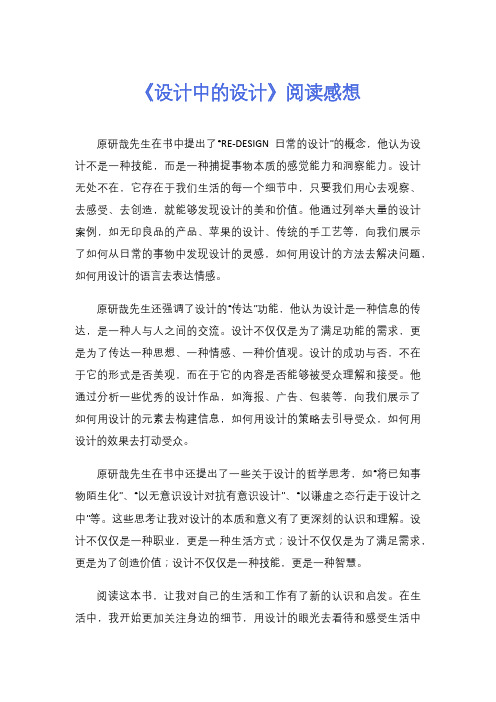
《设计中的设计》阅读感想原研哉先生在书中提出了“RE-DESIGN日常的设计”的概念,他认为设计不是一种技能,而是一种捕捉事物本质的感觉能力和洞察能力。
设计无处不在,它存在于我们生活的每一个细节中,只要我们用心去观察、去感受、去创造,就能够发现设计的美和价值。
他通过列举大量的设计案例,如无印良品的产品、苹果的设计、传统的手工艺等,向我们展示了如何从日常的事物中发现设计的灵感,如何用设计的方法去解决问题,如何用设计的语言去表达情感。
原研哉先生还强调了设计的“传达”功能,他认为设计是一种信息的传达,是一种人与人之间的交流。
设计不仅仅是为了满足功能的需求,更是为了传达一种思想、一种情感、一种价值观。
设计的成功与否,不在于它的形式是否美观,而在于它的内容是否能够被受众理解和接受。
他通过分析一些优秀的设计作品,如海报、广告、包装等,向我们展示了如何用设计的元素去构建信息,如何用设计的策略去引导受众,如何用设计的效果去打动受众。
原研哉先生在书中还提出了一些关于设计的哲学思考,如“将已知事物陌生化”、“以无意识设计对抗有意识设计”、“以谦虚之态行走于设计之中”等。
这些思考让我对设计的本质和意义有了更深刻的认识和理解。
设计不仅仅是一种职业,更是一种生活方式;设计不仅仅是为了满足需求,更是为了创造价值;设计不仅仅是一种技能,更是一种智慧。
阅读这本书,让我对自己的生活和工作有了新的认识和启发。
在生活中,我开始更加关注身边的细节,用设计的眼光去看待和感受生活中的美好和乐趣。
我开始尝试用设计的方法去解决生活中的问题,如如何更方便地整理衣物、如何更健康地饮食、如何更有效地学习等。
我发现,通过设计的思维和方法,我能够更好地满足自己的需求,提高自己的生活质量。
在工作中,我开始更加注重设计的传达功能,用设计的语言去表达自己的想法和观点。
我开始尝试用设计的策略去引导和影响他人,用设计的效果去打动和感染他人。
我发现,通过设计的手段,我能够更好地与他人沟通和合作,提高工作的效率和质量。
书籍《设计中的设计》读书心得感悟体会

书籍《设计中的设计》读书心得感悟体会书籍《设计中的设计》读书心得感悟体会1曾经看过一本原研哉的《设计中的设计》,后来在图书馆看见一本叫《设计中的设计(全本)》的书,书的容量较之前者多了两倍,增加了很多新的章节,书名由designofdesign变成了designingdesign,反映了作者在重新编排此书时思想上的波动。
原研哉是为平面设计大师,却对我们已然习惯了的与日常生活息息相关的产品做了大量再设计课题,书中收录了他策划的再设计的很多精彩作品展,当然其目的并不是为了告诉我们人类自古以来积累起来的智慧所创造出来的产品是多么的“错”,他的研究告诉了热爱设计的人们不要被束缚于日常生活的高墙中,“从‘无’开始固然是一种创造,而把熟知的日常生活变得陌生则更是一种创造。
”他想传播的也是他一直所追求的设计思想。
夏日炎炎,读这本从封面到内页都是纯白的书让人无论从视觉上还是心理上都有一股清凉感,第一章RE—DESIGN——二十一世纪的日常用品是旧内容,坂茂的方形卫生纸筒,佐藤雅彦的出入境章,隈研吾的捕蟑盒,都是我们非常熟悉的作品,“在我们日常生活中,似乎到处手抖充斥着设计,地板,书籍,灯具,啤酒瓶。
这些的确都是设计的产物,将这些东西陌生化,再进一步捕捉到新鲜感进行再设计,并不是一件容易的事,能够做到这一点,才是一个真正的设计师。
”Haptic——无感的觉醒,人有五感;视觉,听觉,味觉,嗅觉和触觉,这个策划中原研哉要求设计师们不许画草图直接受“触觉”来激发出物体。
Haptic的展览中有两个作品我十分喜欢,深泽直人——果汁的肌肤,看到这一系列的作品时顿觉内心一阵清凉,甚至一个荒唐的理念从脑海中飘过:要是能进他的设计公司做设计跟大师一起做设计这辈子就完满了,好好练口语吧!如同作者所写,这一系列最出彩是香蕉汁盒,让人看到后会有从盒子口撕开纸盒大口喝的冲动,因为那里有一处香蕉蒂的设计,这样就会联想到撕开香蕉的动作,于是让人不自觉的想要撕开纸盒,我的感触是不是太大,不知不觉就掉入了设计师的陷阱里,这就是他的设计哲学“nothought”;草莓汁盒的外部肌理处理的和真实的草莓完全一样,有让人想伸手触摸的冲动,仿佛盒盖未启草莓的香甜已经扑面而来,可恨那只是张图片。
大师引导——设计中设计读后感

大师引导——设计中设计读后感大师的引导——《设计中的设计》读后感以“RE-DESIGN”为主线,书中介绍了一些令人印象深刻的设计及他个人的设计,并有一章谈及对日本消费欲望的引导。
全书的创意虽然令人惊喜,但令我如觅良师益友的是他对日本的思考和他所推崇的精神,都令我深深地折服。
书中讲到每一个设计都离不开节约资源这个中心,更深的层次就是如何与自然和谐相处。
他说“不是要为物施加人的力量,而是等待自然的给予”,他推崇日本的简单意象——在空物一物的空间里配置一点东西。
他所展示的那些案例几乎都是简单而蕴育深长的。
就如日本的经济一样,处于成熟期的日本设计对设计领域的重新配置,应该突显她成熟文化的典雅。
全书另我感动的地方有两个。
一个是原研哉对日本的热爱。
他说“每当我来到别的国家,就会更加关注日本,对自己无法完全呈现日本文化感动着急。
我出生在日本,我愿意用心凝视我们脚下这块土地。
”但不盲目,他深入剖析了日本经济科技的发展,承认不足与展望未来,字字谦卑却掩盖不住他的大师风范。
另一个是对所处自然环境的热爱,不推崇同西方文化一样以自我为中心的个性十足的色彩斑斓的设计,他引导的是一种与自然和谐相处的设计。
书中讲到一种四角形的纸管卫生纸的设计:四角形的纸管,在抽取时有一定的阻力,这个设计在于造成不便,这种阻力发出的信息和实现的功能是节约资源。
这个案例正是从细微中体现了他的这种理念。
读完全书,使我对设计对创意有了更深层次的思考。
什么是真正的设计,什么设计才有创意。
不再是我认为的横空出世,绝无仅有的东西。
“设计不是一种技能,而是捕捉事物的感觉能力和洞察能力。
所以。
所以设计要时刻保持对社会的敏感度。
”是的,对社会的敏感度。
“艺术发生的根本立足点是作为个体的个人,而设计的落脚点更侧重于社会。
”摈弃狭隘的个人主义,用敏感的触角去思考周围的事物,下意识地将这些思考过的东西运用到日常生活中。
由此告诫自己:视野要开阔,触角要细腻。
在认知和把握世界的时候,多阅读大师的作品,对自己审美水平的提高和设计理念的形成是非常有帮助的。
小学英语单元整体设计的实践 读后感
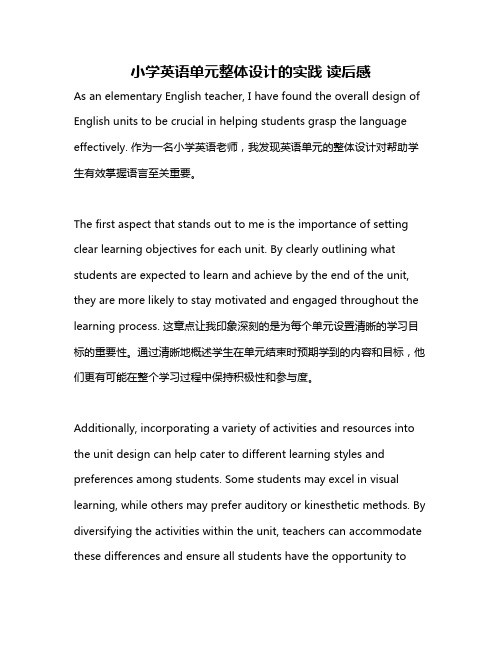
小学英语单元整体设计的实践读后感As an elementary English teacher, I have found the overall design of English units to be crucial in helping students grasp the language effectively. 作为一名小学英语老师,我发现英语单元的整体设计对帮助学生有效掌握语言至关重要。
The first aspect that stands out to me is the importance of setting clear learning objectives for each unit. By clearly outlining what students are expected to learn and achieve by the end of the unit, they are more likely to stay motivated and engaged throughout the learning process. 这章点让我印象深刻的是为每个单元设置清晰的学习目标的重要性。
通过清晰地概述学生在单元结束时预期学到的内容和目标,他们更有可能在整个学习过程中保持积极性和参与度。
Additionally, incorporating a variety of activities and resources into the unit design can help cater to different learning styles and preferences among students. Some students may excel in visual learning, while others may prefer auditory or kinesthetic methods. By diversifying the activities within the unit, teachers can accommodate these differences and ensure all students have the opportunity tolearn in a way that suits them best. 此外,将各种活动和资源纳入单元设计中,可以帮助满足学生之间不同的学习风格和偏好。
英语教学设计读后感范文

英语教学设计读后感范文English:After completing the English teaching design, I feel that incorporating a variety of activities and resources is essential in engaging students and promoting language learning. By integrating listening, speaking, reading, and writing tasks into the lesson plan, students are able to practice and develop all language skills. Additionally, including real-world tasks and authentic materials allows learners to apply their language skills in meaningful contexts. The use of technology, such as online games and interactive exercises, also enhances student engagement and motivation. Overall, designing English lessons that are interactive, diverse, and relevant to students' lives is crucial for creating a stimulating and effective learning environment.Chinese:完成英语教学设计后,我认为融入各种活动和资源对于吸引学生并促进语言学习至关重要。
英语教学活动设计与应用读后感
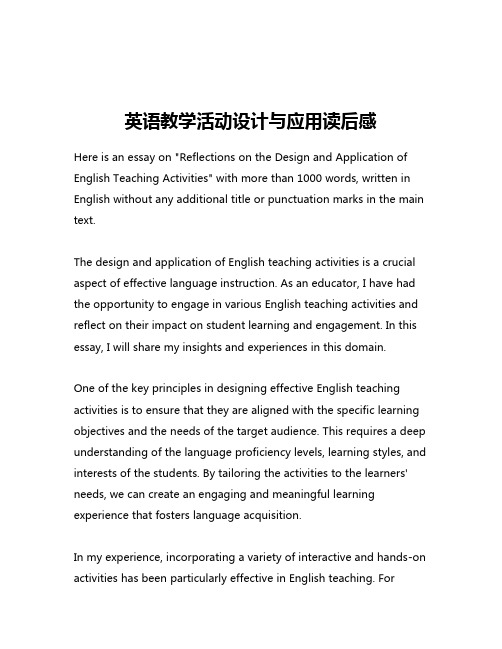
英语教学活动设计与应用读后感Here is an essay on "Reflections on the Design and Application of English Teaching Activities" with more than 1000 words, written in English without any additional title or punctuation marks in the main text.The design and application of English teaching activities is a crucial aspect of effective language instruction. As an educator, I have had the opportunity to engage in various English teaching activities and reflect on their impact on student learning and engagement. In this essay, I will share my insights and experiences in this domain.One of the key principles in designing effective English teaching activities is to ensure that they are aligned with the specific learning objectives and the needs of the target audience. This requires a deep understanding of the language proficiency levels, learning styles, and interests of the students. By tailoring the activities to the learners' needs, we can create an engaging and meaningful learning experience that fosters language acquisition.In my experience, incorporating a variety of interactive and hands-on activities has been particularly effective in English teaching. Forinstance, role-playing exercises allow students to practice conversational skills in a simulated real-world context. These activities not only enhance language proficiency but also develop essential communication and critical thinking skills. Similarly, group-based projects encourage collaboration, problem-solving, and the application of language skills in a practical setting.Another important aspect of English teaching activities is the integration of technology. The digital age has brought forth a wealth of resources and tools that can greatly enhance the learning experience. From interactive language learning platforms to multimedia presentations, the strategic use of technology can make English lessons more engaging, interactive, and accessible to students. By leveraging these technological advancements, educators can create dynamic and immersive learning environments that cater to the needs of the digital-native generation.In addition to the design of the activities, the implementation and facilitation of these lessons are equally crucial. Effective English teachers must possess strong classroom management skills, the ability to adapt to changing dynamics, and the capacity to provide timely and constructive feedback to students. By fostering a supportive and inclusive learning environment, teachers can encourage students to take risks, actively participate, and embrace the language-learning process.Moreover, the assessment and evaluation of English teaching activities play a vital role in determining their effectiveness and guiding future instructional decisions. Incorporating a range of assessment methods, such as formative assessments, summative evaluations, and self-reflections, can provide valuable insights into student progress and the overall impact of the teaching activities. This data-driven approach allows educators to continuously refine and improve their instructional practices, ensuring that they remain responsive to the evolving needs of their students.Throughout my experience in English teaching, I have also come to appreciate the importance of incorporating cultural elements into the activities. By exploring the cultural nuances and societal contexts associated with the English language, students can develop a deeper understanding and appreciation for the diversity of the language. This cross-cultural approach not only enhances language learning but also fosters intercultural competence, an essential skill in our increasingly globalized world.Furthermore, the design and application of English teaching activities should consider the broader educational landscape and the alignment with relevant curriculum standards and frameworks. By ensuring that the activities are well-integrated into the overall educational objectives, teachers can create a cohesive andcomprehensive learning experience for their students.In conclusion, the design and application of English teaching activities is a multifaceted and dynamic process that requires a deep understanding of pedagogy, technology, assessment, and cultural awareness. By continuously reflecting on and refining our instructional practices, we can create engaging and effective learning environments that empower students to develop their English language proficiency and become confident and effective communicators in the global arena.。
初中英语教学活动设计读后感 范例
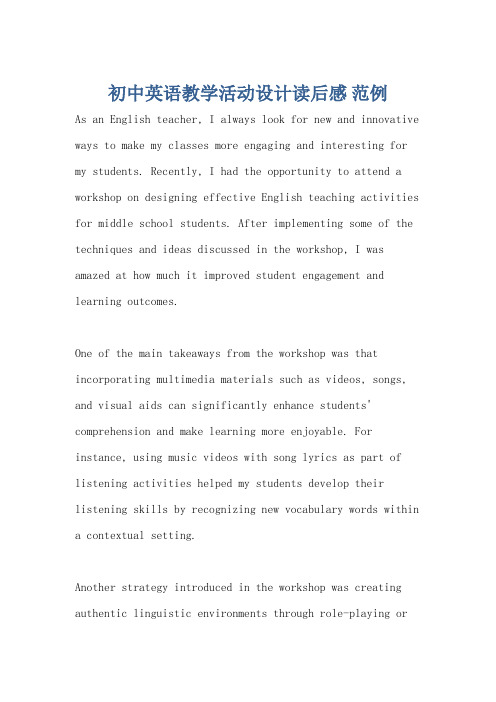
初中英语教学活动设计读后感范例As an English teacher, I always look for new and innovative ways to make my classes more engaging and interesting for my students. Recently, I had the opportunity to attend a workshop on designing effective English teaching activities for middle school students. After implementing some of the techniques and ideas discussed in the workshop, I was amazed at how much it improved student engagement and learning outcomes.One of the main takeaways from the workshop was that incorporating multimedia materials such as videos, songs, and visual aids can significantly enhance students' comprehension and make learning more enjoyable. For instance, using music videos with song lyrics as part of listening activities helped my students develop their listening skills by recognizing new vocabulary words within a contextual setting.Another strategy introduced in the workshop was creating authentic linguistic environments through role-playing orsimulated dialogues. This enables students to practice language use in real-world situations which in turn enhances their communication skills. By encouraging student participation through interactive activities like role-play or drama exercises also makes learning fun and memorable.Furthermore, a student-centered approach where learners are encouraged to work collaboratively is another key aspect highlighted during this workshop. By dividing my class into small groups with different roles assigned such as leader, note-taker or reporter during discussions has greatly increased interaction between classmates and fostered collaborative problem-solving skills development.In conclusion, participating in this workshop offered many valuable insights on how to create successful teaching activities that cater to individual differences of each student while maintaining a fun atmosphere. Students learn better when they are engaged, interested, and involved - often through interacting rather than passively receiving information. It provided me with innovative ways to inspire my students’ interest in English while improving theirproficiency level gradually but steadily- allowing them not only to be well-prepared academically but also more confident communicators overall.。
英语教学设计读后感
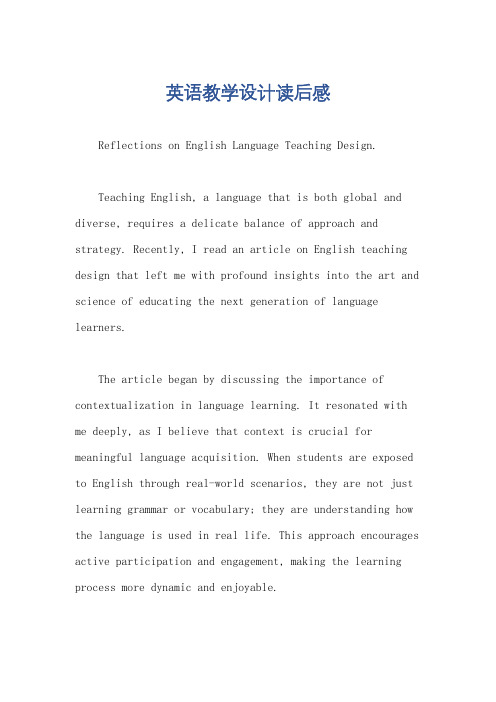
英语教学设计读后感Reflections on English Language Teaching Design.Teaching English, a language that is both global and diverse, requires a delicate balance of approach and strategy. Recently, I read an article on English teaching design that left me with profound insights into the art and science of educating the next generation of language learners.The article began by discussing the importance of contextualization in language learning. It resonated with me deeply, as I believe that context is crucial for meaningful language acquisition. When students are exposed to English through real-world scenarios, they are not just learning grammar or vocabulary; they are understanding how the language is used in real life. This approach encourages active participation and engagement, making the learning process more dynamic and enjoyable.The author also emphasized the role of technology in modern language classrooms. The integration of digitaltools and platforms not only enhances the learning experience but also prepares students for the digital world they will inherit. Technology provides a platform for interactive learning, collaborative projects, and access to a wealth of resources that were unavailable in traditional classrooms. However, it's important to strike a balance between technology use and traditional teaching methods to ensure that students develop a solid foundation in the language.Another significant aspect discussed in the article was the importance of cultural awareness in language learning. Language and culture are intricately linked, and understanding the latter is crucial for mastering the former. When students are exposed to the culture andhistory behind English, they gain a deeper understanding of the language and its usage. This approach also helps to foster a global perspective, preparing students to interact and communicate effectively with people from diverse backgrounds.The article also touched on the role of teachers in language education. Teachers are not just facilitators of knowledge; they are mentors and guides who shape the learning journey of their students. Their approach, attitude, and commitment to the subject matter have a profound impact on the learning outcomes of their students. Teachers need to be continuously updated with the latest teaching methods and techniques to ensure that they are providing the best possible education to their students.Finally, the article concluded with a call for a more holistic approach to language teaching that focuses on developing not just linguistic skills but also cognitive, emotional, and social abilities. This resonated deeply with me, as I believe that education should aim to cultivate well-rounded individuals who are not just academically proficient but also emotionally intelligent and socially responsible.In conclusion, the article on English teaching design provided me with valuable insights into the art and scienceof language education. It reinforced the belief that context, technology, culture, and teacher's role are all integral to effective language learning. As an educator, I am committed to implementing these principles in my classroom to provide my students with a rich and engaging learning experience that will help them become proficient and responsible language users.。
小学英语单元整体设计的实践 读后感
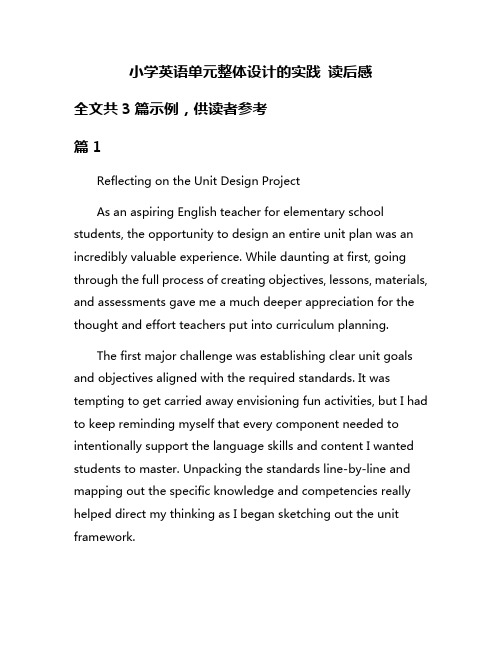
小学英语单元整体设计的实践读后感全文共3篇示例,供读者参考篇1Reflecting on the Unit Design ProjectAs an aspiring English teacher for elementary school students, the opportunity to design an entire unit plan was an incredibly valuable experience. While daunting at first, going through the full process of creating objectives, lessons, materials, and assessments gave me a much deeper appreciation for the thought and effort teachers put into curriculum planning.The first major challenge was establishing clear unit goals and objectives aligned with the required standards. It was tempting to get carried away envisioning fun activities, but I had to keep reminding myself that every component needed to intentionally support the language skills and content I wanted students to master. Unpacking the standards line-by-line and mapping out the specific knowledge and competencies really helped direct my thinking as I began sketching out the unit framework.Determining an overarching unit theme that could engage young learners was also tricky. The theme of "Friends Around the World" seemed full of potential for making cross-cultural connections and celebrating diversity. However, I soon realized I needed to carefully narrow the scope to ensure the material wasn't overwhelming for the intended age group. Focusing the theme on just a few countries and concentrating on simple vocabulary related to greetings, names, and basic personal information allowed me to design much more age-appropriate and achievable lessons.One of the most time-consuming but rewarding aspects was creating all of the materials and classroom resources myself. Everything from handouts and visual aids to games and interactive activities had to be planned out in great detail. While it was laborious to build each component from scratch, it gave me a new-found respect for how thoughtfully prepared an effective teacher needs to be. Little considerations like formatting, visuals, and directions all affect how smoothly lessons run. I spent hours tinkering with PowerPoint slides, cutting out cardboard greeting plates for a speaking activity, and scripting dialogues to model language patterns. As tedious as some of the prep work was, I knew it would pay off bystrengthening my lesson delivery and keeping students engaged.Planinning varied formative assessments throughout the unit was another challenging but insightful process. It forced me to continually re-evaluate whether the activities, tasks, and materials I designed truly provided students with adequate opportunities to practice, apply, and demonstrate mastery of the content. Creating assessment rubrics with clearly defined expectations helped me recognize gaps where I needed to adjust lessons or add more targeted exercises.While the summative assessment allowed for evaluating students' overall grasp of the unit objectives, the formative checks along the way provided crucial checkpoints for monitoring student progress and informing my teaching. An unexpected benefit of having built-in assessments was that it pushed me to incorporate more universal design for learning principles into my materials and delivery methods—considering multiple means of representation, action/expression, and engagement from the start.In the end, the most fulfilling part was envisioning how all of the pieces could culminate in a lively, collaborative final project—creating engaging videos where student groupsintroduced themselves and interviewed friends from around the world. While videos could easily be recorded separately, I'm picturing the energizing chaos of groups working together with props, rotating through interview stations, rehearsing lines, and proudly filming their final takes to be compiled and celebrated. Not only does this type of contextualized performance task create authentic reasons for communication, but it also facilitates students taking ownership of their learning in a way worksheets and tests never could.On a personal note, this project solidified my passion for becoming an elementary English teacher while also unveiling just how much thoughtful hard work goes into designing an effective, standards-based curriculum. While the level of detail involved in mapping out every aspect of instruction was sometimes overwhelming, it instilled in me a deeper appreciation for masterful teaching as both an art and a science.From deconstructing the standards and aligning activities to the precise wording of directions and counting out manipulatives, there were constant opportunities to analyze things from a student's perspective—measuring complexity, anticipating confusion, inserting scaffolding, and embedding differentiation. Balancing quality student engagement withmaximal opportunities for authentic language practice was always top of mind.Even more importantly, this process highlighted how curriculum planning itself is an inherently creative act with teachers as designers sculpting rich, customized learning journeys for their students. There are infinite ways to thoughtfully sequence, structure, and facilitate activities while upholding the standards and core goals. Two teachers could take the same broad concept and craft entirely distinct units with unique "desert trails" based on their own innovative ideas, personal teaching styles, and unique group of learners.More than anything, this project was a powerful reminder that exemplary teachers aren't just "executors" who follow a prescribed script, but rather "architects" and "artists" who carefully construct nuanced, student-centered learning experiences. From this foundational unit design exercise, I've gained invaluable insights and a recharged commitment to becoming a masterful teacher-designer devoted to sparking wonder and catalyzing growth in every student.篇2Reflections on Designing an English Unit PlanAs an elementary education student, one of the most valuable experiences I've had was designing an entire unit plan for teaching English to young learners. While creating individual lesson plans is crucial, developing a coherent, well-structured unit allowed me to deeply understand how the pieces fit together to build knowledge over time. This process has given me insights that will undoubtedly shape my approach to teaching English in the future.The first step was establishing the overarching goals and core concepts for the unit. I had to think critically about what I wanted students to ultimately take away - not just linguistic knowledge like vocabulary and grammar, but also higher-order skills like reading comprehension strategies. Aligning these goals to curriculum standards was essential to ensure my unit properly prepared students.With goals set, I then had to map out a logical sequence for introducing material in a scaffolded way. Simply putting lessons in random order would have been confusing and ineffective. Instead, I had to analyze how concepts connected and built upon each other. For example, students needed basic sentence structures before working on more complex writing. Purposefully ordering and linking lessons created a cohesive flow.Crafting engaging, multimodal lessons was the next crucial component. Reading boring passages or completing rote worksheet after worksheet would have been torturous for young learners. I had to design activities that captured their interests and tapped into different learning modalities like visuals, movement, music, games, and technology. Varying tasks not only made lessons more fun, but reinforced skills in diverse ways to improve retention.Perhaps most critically, I had to develop formative and summative assessments integrated throughout the unit. Merely teaching without any checks for understanding would have been pointless. Thoughtful assessments - from informal observation to culminating projects - allowed me to continuously monitor progress, reteach as needed, and ensure students were grasping concepts before moving forward. Without this feedback loop, my unit would have lacked accountability.In addition to academics, I also had to consider classroom management routines and community-building experiences. Establishing clear procedures and positive behavior supports from day one sets the right tone. Likewise, team-building exercises and celebrating student achievements cultivate anenvironment where learners feel safe, motivated, and respected as individuals. These pieces are vital for effective learning.Altogether, it was extremely rewarding to take a birds-eye view of the entire English instructional process rather than just segmented lessons. Developing the comprehensive unit solidified how purposeful planning, coherent progression, multimodal engagement, integrated assessments, and classroom culture all intertwine. It has prepared me to thoughtfully guide students' long-term language acquisition in a developmentally-appropriate, student-centered way.Of course, designing such a robust unit from scratch was immensely challenging, requiring countless hours of detailed planning and creative problem-solving. At times, I felt overwhelmed trying to perfectly align all the intricate pieces while differentiating for diverse learners. How could I ensure each lesson flowed logically while still offering variety? How could assessments be rigorous yet understandable and unintimidating for young children? Tough decisions had to be made through careful consideration of pedagogical principles and knowledge of my hypothetical students.On multiple occasions, I faced roadblocks that forced me to rethink and revise major aspects of the unit. For example, Ioriginally included two texts covering similar themes, but realized that was redundant when I could bring in other rich literature and writing activities instead. In another instance, I had struggled to incorporate technology in an engaging yet meaningful way beyond just flashy gimmicks. After pushback from my professor, I redesigned those lessons with much stronger cross-curricular ties and authentic applications of edtech tools.Working through those sticking points was grueling, but that iterative process was immensely valuable. Overhauling components deepened my understanding of curriculum design and pushed me to ensure every aspect served a clear purpose. While these revisions required more work, they elevated the unit's quality and coherence. I now better appreciate how exemplary curriculum isn't something shallow generated in an afternoon - it emerges through continuous improvement grounded in research and experience.Beyond academics, this assignment has cultivated invaluable professional skills I will lean on as an educator. Mapping out a large-scale project and adhering to strict deadlines sharpened my project management abilities. Consulting scholarly resources to justify pedagogical decisions strengthened my researchprowess. Repeatedly revising components based on feedback honed my resilience and ability to implement constructive criticism. All of these transferable competencies will serve me well in any educational career.Most importantly though, this process has solidified my passion for teaching. Envisioning how lessons would unfold in an actual classroom filled me with excitement and renewed my drive to spark students' curiosity. While the planning was arduous, visualizing children's faces lighting up as they engaged in culturally-responsive, joyful learning made those long hours deeply gratifying. I'm filled with a sense of purpose knowing the effort I've poured into this unit will cultivate impactful, equitable learning experiences.As I reflect, I'm profoundly grateful for this authentic opportunity to design an entire English unit plan. Theory and individual lesson planning are crucial, but grappling with the entire instructional process has immersed me in the art of teaching in a uniquely holistic way. The skills I've developed - aligning objectives, crafting engaging activities, integrating assessments, building classroom community, managing projects, thinking critically, and more - will undoubtedly shape my effectiveness as an educator moving forward.While this unit plan may live on as just an assignment, the process itself has been transformative preparation for my career.I have a deeper respect for the complexity of curriculum design and its profound impacts on student learning. Most importantly, I've gained greater confidence in my ability to create equitable, empowering educational experiences that will unlock language and life opportunities for all children. Though challenges certainly lie ahead, immersing myself in this comprehensive unit design has equipped me with an invaluable foundation for nurturing curious, capable, caring learners and leaders of tomorrow.篇3An Overall English Unit Design Experience: A Student's ReflectionAs an aspiring English teacher pursuing my education degree, I recently had the invaluable opportunity to design an entire unit plan for teaching English to elementary school students. This hands-on project allowed me to apply the theoretical knowledge gained in my courses to a practical,real-world context. The experience was both challenging and rewarding, providing me with insights that will undoubtedly shape my future teaching practices.The task at hand was to create a comprehensive unit plan for a specific grade level, encompassing various language skills such as reading, writing, listening, and speaking. The unit needed to align with the prescribed curriculum standards and learning objectives while incorporating engaging activities and assessments tailored to the developmental needs of the target age group.Before delving into the unit design process, I spent considerable time researching and analyzing the unique characteristics of the elementary school learners I would be catering to. Understanding their cognitive abilities, attention spans, and preferred learning styles was crucial in crafting lessons that would effectively capture their interest and facilitate meaningful learning experiences.With a solid foundational understanding of my target audience, I began mapping out the unit's overarching goals and essential questions. These guiding principles served as the backbone for the entire unit, ensuring that each lesson and activity contributed to the overall learning objectives. Establishing clear and measurable targets from the outset proved invaluable in maintaining focus and coherence throughout the design process.One of the most significant challenges I encountered was striking the right balance between covering the required content and incorporating interactive, student-centered activities. It was tempting to rely heavily on traditional teaching methods, such as lectures and worksheets, as they provide a structured approach to content delivery. However, I quickly realized that to truly engage elementary school learners, I needed to infuse the unit with a variety of hands-on, collaborative, and multimedia-based activities.Designing these interactive components required a great deal of creativity and resourcefulness. I explored various online platforms, educational games, and multimedia resources that could supplement and enhance the learning experience. Incorporating elements of fun and play into the lessons not only made the content more accessible but also fostered a positive and inclusive learning environment.Assessments played a pivotal role in the unit design process, as they served as a means to gauge student progress and adjust instruction accordingly. I carefully crafted formative and summative assessments that aligned with the learning objectives and catered to diverse learning styles. From informal observations and exit tickets to project-based assessments andportfolio submissions, I aimed to provide multiple avenues for students to demonstrate their understanding and growth.Throughout the design process, I encountered numerous challenges and had to make adjustments and revisions along the way. Feedback from my professors and peers proved invaluable in identifying areas for improvement and refining my approach. I learned the importance of flexibility and adaptability, as no unit plan can account for every potential scenario or learner need that may arise in the classroom.One aspect that I found particularly rewarding was the opportunity to incorporate culturally responsive and inclusive practices into the unit design. By carefully selecting diverse texts, materials, and examples, I aimed to create an environment where all learners felt represented and valued. Additionally, I incorporated strategies to support English language learners and students with diverse learning needs, ensuring that the unit was accessible and engaging for a wide range of learners.As I neared the completion of the unit design, I couldn't help but feel a sense of accomplishment and excitement. The culmination of this project not only demonstrated my ability to apply theoretical knowledge to practice but also reinforced mypassion for teaching and my commitment to creating meaningful learning experiences for students.Reflecting on this experience, I can confidently say that designing an overall English unit for elementary school students has been a transformative journey. It has provided me with a deeper understanding of the complexities involved in effective curriculum design and has equipped me with valuable skills that will undoubtedly serve me well as I embark on my teaching career.Moving forward, I am eager to continue refining and adapting my unit plan based on real-world implementation and feedback from students and colleagues. The iterative nature of teaching and curriculum design ensures that I will have ample opportunities to continuously improve and grow as an educator.Moreover, this experience has reinforced the importance of ongoing professional development and collaboration within the teaching community. Sharing best practices, seeking mentorship, and staying abreast of the latest pedagogical research and innovations will be crucial in ensuring that my teaching practices remain relevant, engaging, and effective.As I look ahead to my future as an English teacher, I am filled with a renewed sense of purpose and enthusiasm. The skills andinsights gained through this unit design experience have provided me with a solid foundation upon which to build a rewarding and impactful career. I am excited to continue exploring innovative teaching strategies, fostering inclusive learning environments, and inspiring a love for language and learning in the minds of my future students.。
英语教学设计读后感范文
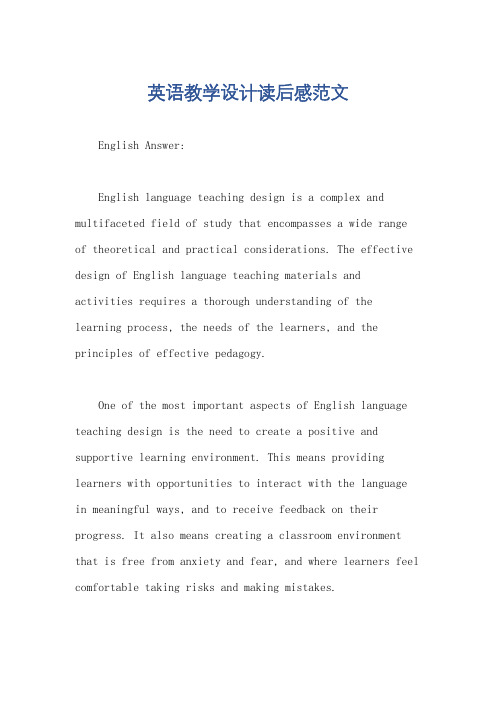
英语教学设计读后感范文English Answer:English language teaching design is a complex and multifaceted field of study that encompasses a wide range of theoretical and practical considerations. The effective design of English language teaching materials andactivities requires a thorough understanding of the learning process, the needs of the learners, and the principles of effective pedagogy.One of the most important aspects of English language teaching design is the need to create a positive and supportive learning environment. This means providing learners with opportunities to interact with the language in meaningful ways, and to receive feedback on their progress. It also means creating a classroom environment that is free from anxiety and fear, and where learners feel comfortable taking risks and making mistakes.Another important aspect of English language teaching design is the need to focus on the learner's individual needs. This means taking into account the learner's learning style, level of proficiency, and cultural background. It also means providing learners with a variety of learning materials and activities that meet their individual needs.Finally, effective English language teaching design requires a strong theoretical foundation. This means being familiar with the latest research on language learning and teaching, and being able to apply this knowledge to the design of teaching materials and activities. It also means being able to critically evaluate existing materials and activities, and to make informed decisions about how to use them in the classroom.中文回答:英语教学设计是一门复杂且多方面的研究领域,涵盖了广泛的理论和实践考量。
《设计中的设计》读后感1000字
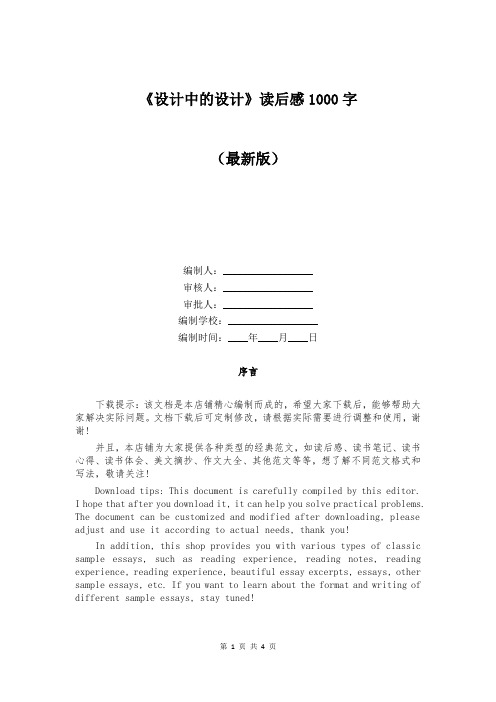
《设计中的设计》读后感1000字(最新版)编制人:__________________审核人:__________________审批人:__________________编制学校:__________________编制时间:____年____月____日序言下载提示:该文档是本店铺精心编制而成的,希望大家下载后,能够帮助大家解决实际问题。
文档下载后可定制修改,请根据实际需要进行调整和使用,谢谢!并且,本店铺为大家提供各种类型的经典范文,如读后感、读书笔记、读书心得、读书体会、美文摘抄、作文大全、其他范文等等,想了解不同范文格式和写法,敬请关注!Download tips: This document is carefully compiled by this editor.I hope that after you download it, it can help you solve practical problems. The document can be customized and modified after downloading, please adjust and use it according to actual needs, thank you!In addition, this shop provides you with various types of classic sample essays, such as reading experience, reading notes, reading experience, reading experience, beautiful essay excerpts, essays, other sample essays, etc. If you want to learn about the format and writing of different sample essays, stay tuned!《设计中的设计》读后感1000字《设计中的设计》读后感1000字:这本书无法让人更懂设计,它为你武装设计的思维,并要求你不断迭代关于设计的观念。
- 1、下载文档前请自行甄别文档内容的完整性,平台不提供额外的编辑、内容补充、找答案等附加服务。
- 2、"仅部分预览"的文档,不可在线预览部分如存在完整性等问题,可反馈申请退款(可完整预览的文档不适用该条件!)。
- 3、如文档侵犯您的权益,请联系客服反馈,我们会尽快为您处理(人工客服工作时间:9:00-18:30)。
索尼公司生产的“G”型磁带录音机在技术上是相 当先进的,但看上去像台原型机
With the development of economy, Japan has been aware of the
seriousness of imitating foreign design. By combining their local culs book, You can't find the answer
directly ,because the writer didn‟t gave us a
valuable inspiration . But You will form your own
views of design through this book. Now, let us read this book.
rich land of Japanese culture.
Although the Japanese economy has rapidly developed, it also
led to the division in the industry and the cultural.
1932年日产公司生产的小汽车,显然是刻意模仿 当时欧美流行的车型
this chapter at the airport, one day
there will be fifty thousand surprises. His design gives us a very viable way to communicate with each other.
Designer: Naoto Fukasawa Tea drinking is not just as simple as it
is talked, and it provide atmosphere in
reading and other activities. I hope my designs make people get to enjoy in
those actions almost unconsciously.
Designer: Ban Shigeru If you roll the middle with square paper tube, then you will get a roll of square paper roll, which is perhaps the best way to reduce waste: pulling the paper will not be very smooth, but also produce resistance so you can not use a lot of paper. Furthermore, by reducing display space, the packaging and transporting are more convenient, which reduces costs.
Like its theme color, white bag are suitable for putting a variety of goods.
"Muji (MUJI)" was founded in Japan, its original meaning is "no trademark and high quality." While trying to desalinize the brand awareness, all the products follows the unified design concept by the interpretation of the "Muji" brand image. What it promotes was much admired in quality people.
In general, introducing a book will introduce its author . Here, too.
Kenyahara,who is the Japan international
graphic designer, Japan design center
representatives, Musashino Art University‟s Professor, MUJI(无印良品)‟s art director.
characteristics, Japan has now developed into a typical Japanese design, enjoying an established fame both at home and abroad.
It can detect and analyze brain waves, and with the wearer„s emotional ups and downs, it will make corresponding movement。 For example, the mood is sad, cat ears are drooping; If you concentrate on something , then will be erected; you are happy, cat ears will swing back and forth; when you are tired, it will lie down.
original schedule.
In order to merge different brands together in Matsuya Ginza, Kenyahara
used white as the theme colors.
The glass on the front cover many protruding white dots,which arouse tactile sensations, and can radiate light.
Hey, ladies and gentlemen , Do you know what is the design ?
By:莞工-钟琼伟
To be honest , I don't know ,too.So I want to recommend a book to you, Design Of Design.
take man in a new and fresh environment , but also use overall
experience by familiar things or treatment of surface texture. Next we will discuss the design of “Matsuya Ginza(松屋银座)”.
coated with combustion agent. His idea is
that let them do something for the people before people put these small branches to the earth mother.
Designer: Masahiko Sato
I agree with the author's views. We should critically received various existing life items, because they have survived after the washing of life,
however, because of this, it can only adapt to the era in the past,. For
today's green, ergonomic concept, it is also unreasonable. So, this also
provides an opportunity to redesign.
The so-called " building of information " make people not only
Like Japan , China was also at this stage of copying blindly foreign things.
China is an ancient country with civilization over five thousand years.
If blending chinese styles and high and new technologies in one, a
I don‟t just introduce its main idea.I am willing to
share something personal such as a thought or a
piece of books with you.
Loading……
After the Second World War, many Japanese designers copy European and American modernism, but it get dyspeptic in the
The exit seal is the aircraft to the left, the entry is to the right. The entry and exit procedures, stick out a mile. Seeing that, my mind must left an unforgettable surprise. If we say that there are five million inbound travelers every day, then use
